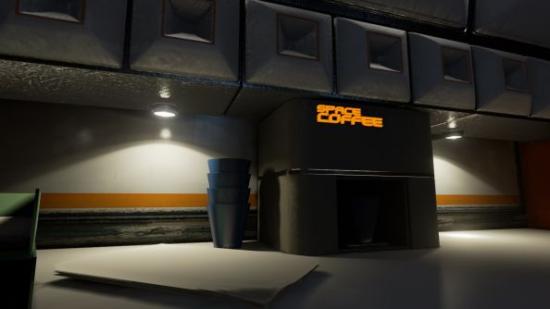It is the near-future. The entire population of Earth is enthusiastically addicted to coffee. Vying corporations build gigantic space stations and send them to the darkest corners of space to mine minerals and synthesize something like the brown stuff.
This is the concept of Caffeine: the one-man horror show proving that the same tech used to build Eve Valkyrie and Fortnite can scale down without compromise.
It is the present day. The entire population of Earth is enthusiastically addicted to coffee. Vying corporations build gigantic games with Unreal Engine 4 – but lone Australian developer Dylan Browne buys a monthly subscription and puts together something called Caffeine.
The game will be a first-person genremate to Alien: Isolation. Players will wake up aboard an abandoned mining station and be left with no choice but to descend into its bean-stained depths looking for answers. The soundtrack will come from a composer in Florida – but the scares, puzzles and prettified corridors will all come solely from Browne.
Working alone is not without its challenges. Browne is developing for VR, and for the most part works with exactly the same tools CCP use for Eve Valkyrie. But for months, shipping restrictions on the Oculus dev kit meant he didn’t have access to a Rift.
“People started asking if Caffeine supports the Rift, and I thought I would do it because I knew that UE4 was going to have native support anyway,” said Browne. “But Australia is just a bad place to be to order an Oculus.”
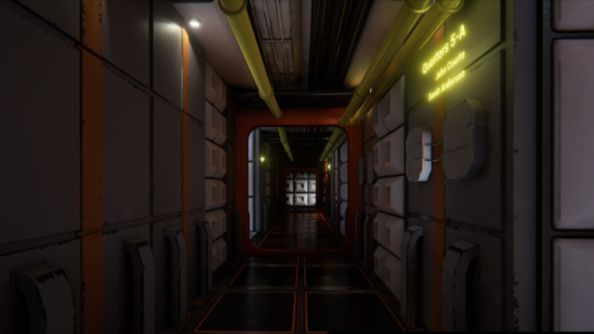
Dev kits are shipped in batches, and Browne had to wait a “very, very long time” before enough were ordered to justify a delivery. In the interim, he resolved to work on VR without the ability to test the results himself.
It’s been a difficult process, made somewhat easier by “generally very good” tools for iteration in UE4. Browne began the project in Unreal 3, and has felt the benefits of the new engine’s ‘re-import’ feature – which allows assets to be updated without the need for swapping between two programs.
“I had Oculus support in there, and I had no idea if it would work,” laughed Browne. “I just had to put it out there on the Oculus Reddit and say, ‘Hey, can you guys test this out?’
“Once I finally got the Rift I was able to actually see what people were talking about when they mentioned issues and optimise it.”
Browne has seen the importance of playtesting reflected, like starlight in his ship’s gleaming floors, at a higher level too. Caffeine belongs to a long line of space station scarefests, and will revolve around the same kind of creeping horror – but the developer has struggled to find subjects to test his jumps on.
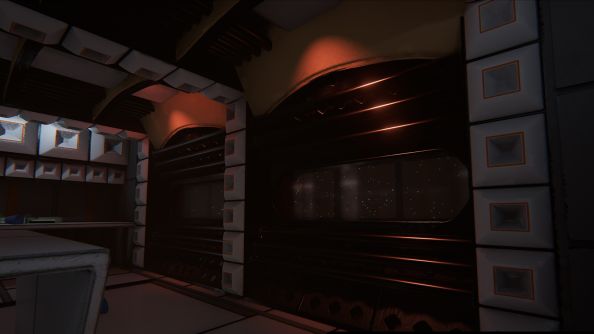
“It’s actually one of the hardest things I’ve found to do,” admitted Browne. “To gauge how people will react to things that are supposed to be scary. Because I’ve placed it all there and I know exactly what’s happening, it just doesn’t faze me at all. So I have no idea if something will make someone jump, or if just the atmosphere in general is really freaky.”
When Browne finally got to show Caffeine at Adelaide’s AVCon, he was relieved. Over two days at the anime and games event, he saw some “really cool reactions”.
“That kind of reinforced that it was actually working,” he said. “Combined with the online reception, that’s my only way of knowing if it’s working or not.”
While Browne is understandably tight-lipped about the precise nature of Caffeine’s scares, he cites lighting as one of the most reliable tools on his fearbelt. Sudden blacknesses and crawling shadows have haunted the space station subgenre since System Shock 2 – but Browne hasn’t had to rely on the baked lighting of 1999. He has UE4.
“Usually the cliché is that you have a really dim room and then you have a bright light when the scare is near to accentuate it,” he said. “But other than that I really like playing with shadows around corners, shadows in vents and coming out of vents. Things which are mostly easy to add but can give a great effect.”
Playing with the engine’s capacity for dramatic lighting is now Browne’s “favourite part of development”.
“I’m really picky with lighting so often I’ll spend about an hour placing one light just to get it right, or changing an entire part of a room because of it,” he said.
The game makes use of new shadowing techniques still being added in Unreal updates. The raytrace soft shadows Epic recently introduced to the engine, for example, crop up in Caffeine as the shade of a nearby sun peering through the station’s windows.
Experiments with extreme angles have yielded spectacular vignettes, and liberal application of spotlights has lent the game a “sci-fi feel”.
“If a light is coming through a vent or something like that, I’ll use a spot,” explained Browne. “Not only is it less performance intensive but you get the circular highlight on the ground and the curved light on the wall.”
As you might be beginning to imagine, performance has been a perpetual battle for Browne. Ghouls might haunt Caffeine’s corridors, but one of the station’s ghosts was wholly accidental – living in a single room and feeding on the game’s frame rate. Dynamic shadows had to be disabled in the game’s Oculus demo until the poltergeist was captured and its abode demolished.
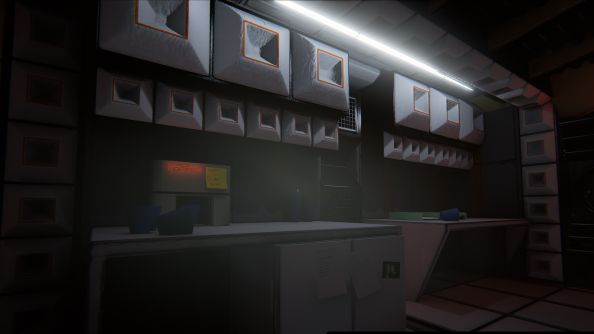
“On my first demo, I think someone that was running a GDX Titan was getting about 30 frames per second,” noted Browne. “With Oculus you need to be hitting about 75 fps all the time, so that obviously wasn’t ideal.”
Sensibly, Browne has since made use of the same World Composition tech found in Dead Island 2 to split areas into streamable blocks. Rooms are drawn into existence when the player draws near, and judiciously-placed airlock-style double doors help to conceal the loading – all without compromise on Caffeine’s look.
Browne’s expertise is in VFX, and he’s set out strict visual rules for himself. The game mostly adheres to a three-colour scheme inspired by Moon – the inventive, low-budget sci-fi film by Warcraft director Duncan Jones. It’s this that wowed press and punters in Caffeine’s early trailers and distinguished the game from the multi-million dollar likes of Isolation.
“I’m a really visual person,” said Browne. “Once people said that I should make a game out of the setting, I instantly thought of how I wanted it to look. Usually I like to stay with a really plain base colour and then have splashes of brightness.”
In level design and all other aspects of Caffeine, Browne has solved his manpower problem with recourse to UE4’s Blueprint system, which makes C++ tasks accessible to non-engineers. “Most of the game” to date has been written this way.
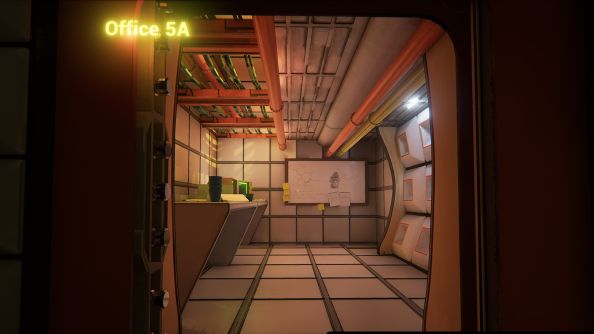
“I’m not by any means a coder, so I’m figuring out ways to do it efficiently and make most of my Blueprints fully reusable,” said Browne. “So for instance, the whole station rotating is driven from a Blueprint. I’ve done some experimentation with it, and parts of the station can actually move independent of the rest.”
It’s what you might call a centri-frugal approach. The developer is keen to mimic “classic sci-fi”, so expect scenes from 2001 and Interstellar recreated on a budget.
Browne is now facing a familiar problem – getting something tested. He’s currently working on a puzzle that sees players emptying huge tanks of coffee like crazed baristas, submerging parts of the station and gaining access to new areas in the process (“The coffee also dirties up the environment, which is pretty cool”).
He’ll release a puzzle-focused alpha version of the game to players who backed Caffeine early on, and is getting “big feedback” from the demo currently available. But all the while, he’s still thinking of new things to do with light and shadow.
“There’s a guy on the forums that I’m hoping to work with on some real-time light bouncing, because I really want that for puzzles,” said Browne. “If I’m able to integrate that, then that will probably be my favourite feature in the entire thing.”
Caffeine is available for pre-order. Unreal Engine 4 development is available to anyone for a $19 monthly subscription fee.
In this sponsored series, we’re looking at how game developers are taking advantage of Unreal Engine 4 to create a new generation of PC games. With thanks to Epic Games and Edge Case.
